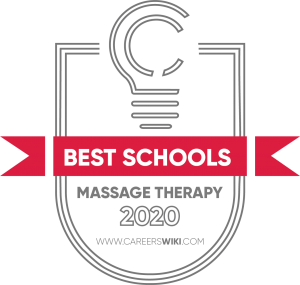…
There are 10 massage therapy schools in Wisconsin, from small private institutions to large public colleges. Some concentrate only on bodywork, while others provide multiple career programs.
The curricula have three components: classroom instruction, lab training, and clinical experience. After less than a year or less, graduates earn certificates or diplomas that allow them to apply for state licensure.
Massage therapy is a thriving occupation in the Badger State, where many practitioners enjoy incomes higher than the national average. Government officials forecast about 360 new jobs annually from 2016-26.
View our top massage therapy schools and programs in other states.

Within this state agency is a credentialing board for massage therapy and bodywork. The panel determines education and examination requirements for practitioners, issuing licenses to those who qualify. It also adopts rules for renewing licenses and receiving continuing education.
Another board duty is to identify schools and programs that meet specified curriculum criteria. Instructors must have a certain level of education and experience. A list of approved institutions is posted online.
The board establishes standards of professional conduct. It launches investigations into possible violations of laws, regulations, and policies. Fines, license suspensions, and license revocations are among the punishments that may result.
A high school diploma or a GED is mandatory for anyone seeking to become a massage therapist in Wisconsin. The next level of education must be at a postsecondary institution with accreditation the state credentialing board accepts.
Board rules stipulate that a massage therapy program total 600 or more content hours of instruction and training. This must include 125 hours in anatomy, physiology, pathology, and kinesiology classes; and 50 hours in business, law, and ethics.
At least 300 hours are to be devoted to massage and bodywork theory, technique, and practice — with 100 hours of supervised, hands-on practice and 20 hours working in a student clinic. Adult cardiopulmonary resuscitation and standard first aid must be addressed in five classroom hours.
Many schools exceed the requirements by providing instruction in a larger variety of massage modalities. Some curricula feature courses preparing students to open their own practices, while others allow for extended clinical experience.
Those who graduate may apply to the state board for licensure. They have to pass a national certification test called the Message and Bodywork Licensing Examination.
The Federation of State Massage Therapy Boards accepts applications to take the exam. Another required test concerns laws and administrative rules in the state.
Every other year, a Wisconsin practitioner must apply for a renewed license. This entails earning 24 hours of continuing education, including two hours in ethics.
We selected the schools below based on the programs that they offer, accreditation, student population, graduation rate and reputation.
View our Ranking Methodology to learn more about how we rank schools.

90%
10
On campuses in Madison and Milwaukee, this school offers an Asian bodywork and therapeutic massage diploma program.
Eight hundred content hours require 10 months of full-time study. A longer, part-time alternative is available. The institute touts its curriculum as containing “the most in-depth modalities of any school in the Midwest.” Courses cover Eastern and Western massage techniques and theory, student chair massage, Western science, and licensing exam preparation.
The program director, Dr. Xiping Zhou, is an expert in traditional Chinese medical acupuncture who also teaches Tai Chi and QiGong. He has more than 25 years of experience in Chinese healing.
82%
53
This family-owned institute has been operating in Eau Claire for more than 20 years. Its massage therapy certificate program involves 630 content hours.
Students receive hands-on training in a variety of massage and wellness modalities, including Swedish, deep tissue, sports, prenatal, and reflexology. They also learn about communication skills and guest services. The program, which lasts 45 weeks, begins two times a year.
In an on-campus salon and spa, students administer full-body, hot stone, and aromatherapy treatments. The school assists with career planning and job searches.
93%
64
A privately owned school, SPA awards certificates in cosmetology, esthetics, and massage therapy.
Students need 25 weeks to finish the MT program. They attend classes and labs Monday through Friday for an average of 30 hours per week. Programs begin in May and October. The 750 content hours of instruction provide training in relaxation and clinical massage methods. The school promises “individualized attention,” with each class limited to eight students.
Program participants get real-world experience in a spa and salon. They serve clients with Swedish, deep tissue, and hot stone massages; as well as aromatherapy treatments.
84%
102
The Aveda cosmetics company began opening beauty and wellness schools in 1977. Today, its North American network has more than 60 institutes. The Madison site is in University Square.
The school “embodies an integrated view of beauty, nutrition, body care, health, and wellness.” The 750-content-hour massage therapy program features an “advanced interactive curriculum” that teaches Swedish massage, reflexology, and aromaology. Students also learn about Ayurveda, India’s ancient healing method.
A student salon and community events provide opportunities for practical experience. There are guest educators, tutors, and career fairs. The school places many of its graduates in jobs at Aveda salons.
73%
498
This is a private, nonprofit institution with dozens of programs. It has nine campuses in seven states, including the Brookfield site in the Milwaukee area.
Herzing offers a diploma in therapeutic massage that involves 900 content hours. Along with the state-mandated courses, students take Health Services Management, Therapeutic Strategies and Decision Making, Wellness and Eastern Philosophy, Hydrotherapy, and Advanced Hydrotherapy. A Specialty Areas in Massage Practices class addresses postural assessment, connective tissue massage, trigger point therapy, remedial exercise and stretching, and positioning.
The curriculum also requires four clinical assignments. The school has career services to aid in students’ job searches.
82%
204
This accredited Aveda beauty school in Milwaukee has programs in esthiology, Ayurvedic esthetics, and massage therapy.
The MT curriculum amounts to 750 content hours, 70 of which students spend in clinical settings. Program length options are 22 weeks full time during the day, 36 weeks part time (three days per week), and 38 weeks of evening classes. Students develop skills in Swedish and deep tissue massage, aromatherapy, chakra, and body opening movements.
Hands-on training takes place in the school’s cadaver labs and specialty clinics. Students receive “one-on-one instruction” and free iPads. There are career fairs and guest speaker workshops.
40%
4004
Located in La Crosse, WTC is one of Wisconsin’s 16 public vocational-technical schools. It is certified by the Commission on Massage Therapy Accreditation.
The MT program is composed of 750 content hours — half classroom lectures and half hands-on training. A pair of internships make up 100 hours. Certificates are awarded after 25 weeks during the day or 47 weeks at night. All instructors have professional experience in the field.
Students learn Swedish massage, hydrotherapy, deep tissue massage, advanced clinical massage, spa and wellness treatments, chair and sports massage, and kinesiology. They also get extensive training in advanced clinical techniques.
23%
15250
This public community college, with more than 150 career programs, serves a 12-county area in south-central Wisconsin.
The 800-content-hour, 28-credit massage therapy diploma curriculum takes full-time students nine months. There is instruction in Eastern and Western modalities, including Swedish, chair, and full-body therapeutic techniques. Classes also teach methods for pregnant women, the elderly, and cancer patients.
The curriculum covers clinical approaches like trigger point therapy and sports massage; and spa treatments such as hydrotherapy, hot stone massage, aromatherapy, and Eastern bodywork. Professional skills, the therapeutic relationship, treatment planning, and body-mind awareness are emphasized.
43%
11505
NWTC awards massage therapy diplomas on its Green Bay and Sturgeon Bay campuses. The program stresses “personal and professional development, increased self-awareness, and sensitivity.”
The 28-credit curriculum delivers instruction in hygiene and safety, myofascial release, deep tissue massage, neuromuscular therapy, spa treatments, Eastern and energetic approaches, medical terminology, pharmacology, kinesiology, and diversity studies. Students are trained in massage techniques for athletes, mothers and infants, the elderly, end of life clients, and those with chronic pain.
One of the program admission requirements is a minimum high school grade-point average of 2.6. Students have access to study-abroad opportunities.
51%
11709
Our top choice is this public community college, which offers more than 200 degree and certificate programs. Massage therapy students, on the Appleton campus, earn technical diplomas.
The full-time program consists of 24 credits. There are day and evening class schedules. Students get training in deep tissue, pregnancy, infant, and pressure point face massage. Other courses teach trigger point therapy, myofascial release, joint movement, neuromuscular therapy, polarity, reflexology, Asian bodywork, Chinese medicine, hydrotherapy, kinesiology, safety and sanitation, and communication skills.
In the school’s Trilogy Salon & Spa, students give Swedish, chair, hot stone, and customized massages to the public.
$20.4
$42,400
18%
The typical practitioner here makes approximately $42,400 a year (or $20.40 per hour)—a little better than the United States median of about 41,420 (or $20).
Income among those in the top tenth of earners is nearly $65,000 (or around $31.20) in Wisconsin—not quite as much as the national average of almost $78,300 (or over $37.60). The pay for the bottom tenth in the state is in excess of $18,850 (or above $9)—less than approximately $21,340 (or $10.25) across the country.
Jobs for massage therapists in Wisconsin totaled 2,820 in 2016. Federal analysts estimated that the figure would reach 3,340 within a decade—an 18 percent increase, compared with the 26 percent that officials expect nationwide.
Sources: U.S. Bureau of Labor Statistics, CareerOneStop

LIMITED TIME DEAL